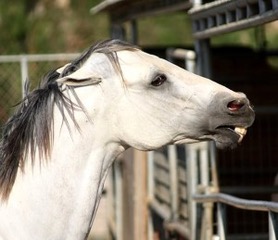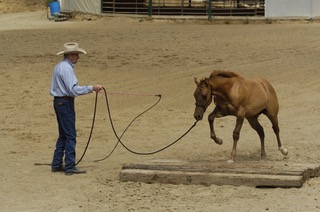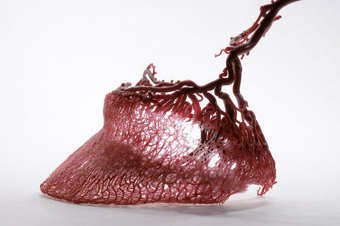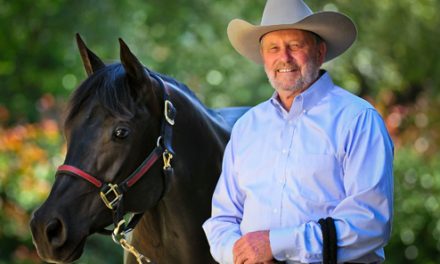
I believe that the forward cue is the most misunderstood and misused of the riding cues. It is often ignored or simply unrecognized by riders as being a vital component of communication with a horse.
In the saddle, a forward cue consists of a squeeze with your leg at the cinch, or what I call the number one leg position. You may also kiss or cluck to the horse before. This is also what you would do when doing hand work. A forward cue is needed to get your horse to come through from the rear with energy. A horse that does not respond to a forward cue will pull itself along, when it does move, and have little energy or life in its feet.
A solid forward cue is critical when you are out on the trail. Without a responsive forward cue, it is likely your horse will not cross a creek or go over any object that may be on the trail. A good forward cue does not mean your horse will be perfect out on the trail but it will eliminate many problematic situations. If you are training your horse to go over objects, a good forward cue is critical and will make your training easier as your horse will understand what you are asking. Some people use treats to coax a horse into a trailer but a horse that is frightened or injured will not respond to food. A strong forward cue is essential in this situation.
I see many riders practice their leg yields, transitions, turnarounds and many other movements but never practice the forward cue. When I practice the forward cue, I put the calf of my leg on the horse and press very lightly. There is a theory that a horse can feel a fly land and I know this is true because I have watched many horses twitch their skin when a fly lands on them. So, we don’t need to start this cue by pressing with three pounds of pressure. Squeeze a little with no more than one pound of pressure. If the horse does not respond, you must follow up by increasing the pressure using your leg, spur or a dressage stick. The spur or stick is the last thing to be used.
A horse that has never been taught to go forward will likely not listen and may get cranky when asked to go forward. There will likely be some attitude involved which may be demonstrated by ear flattening and tail swishing. If you fail to follow up, you are teaching your horse to ignore the cue.
Some riders don’t like to increase the pressure because it may cause an adverse reaction. The horse might kick out or even buck. It may have attitude because it has not been required to comply with your cues. You need to decide if you are willing to deal with a possible reaction. Are you comfortable and confident enough to follow through with a spur or a dressage stick to send your horse forward?
You also need to recognize when your horse has gone forward. Just because the horse moves into a trot, does not mean the horse is going forward. If there is no life in the trot, but just chug, chug, chug, your horse is not going forward. You have to make sure there is life in the feet and you feel a thrust forward. We don’t want the horse going too fast; we don’t want a runaway trot or a hand gallop but once you get forward movement with energy, it is easier to bring the horse back into a relaxed gait. It is much more difficult to get a horse forward with energy in a relaxed gait.
With a responsive forward cue, the body dynamics of a horse change from pulling itself along to coming through from the rear and pushing. I get a lot of horses here for training that are all muscled up in the front from pulling themselves along. They have no hip muscles and no top line because they have never been asked to come through from the rear and get up under themselves. You can’t accomplish this type of movement without a forward cue. I have two new horses here at the barn now and the owner is amazed because they are going forward. The forward cue is a basic building block in the training of a horse. We have to be willing to send the horse forward, on the ground or in the saddle. With a horse that has never been asked to go forward, I start on the ground because it is easier and safer.
As I said, there may be some consequences as you up your standards and require more from your horse. If you find the consequences are more than you can deal with, you will need some help. That is why most riders need a trainer at some point. A trainer can work through the consequences with the horse and help you develop your skills and confidence. You can learn to get your horse to move off your leg, not only forward, but laterally. It is amazing that once you get a horse listening to the leg cue, the horse will also start listening to the seat cues. This means you may need to up your game by knowing proper body position and cues, being consistent in how you apply the cues and by being willing to follow through when the horse does not respond.
Practice your forward cue, make sure your horse is sensitive to pressure from your leg by applying the least amount of pressure. We don’t want to desensitize the horse because we don’t want a dull horse. A dull horse has no life in the feet or energy in the body.
We want a horse that responds to light cues and goes forward willingly with energy and spirit so that the horse will:
Have a good attitude
It will be more fun and safer for you going up the trail
It will be more willing to go over objects
Load into your trailer with no fuss
Will come from the rear and have a well muscled hip and great top line,
And you will have many great rides.




